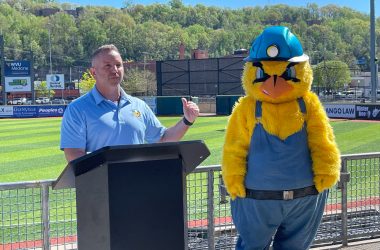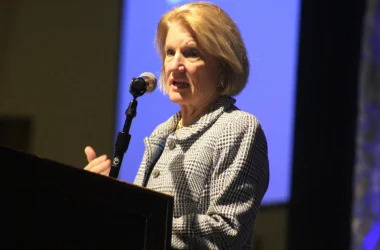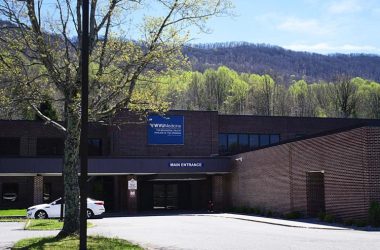By SEAN O’DONOGHUE
Managing Editor
HAMLIN, W.Va. — Lincoln County leads the way; that’s not heard often enough. As efforts continue statewide to advance broadband access throughout West Virginia, and increase available speeds to residential and business consumers, available Internet services in Hamlin and throughout many parts of Lincoln County have long outpaced regional, state, and national speeds.
Now, business, government, and economic development leaders in the county are looking to reach out to potential entrepreneurs and corporate interests to make sure they know Lincoln County is at the forefront for data capabilities. Meanwhile, in other parts of the state, the broadband map is far patchier, with federal lawmakers continuing their work to expand access.
The preeminent provider of broadband services in Lincoln County, Armstrong, has exceeded stated minimum broadband standards for quite some time. In comments to The Lincoln Journal, Hamlin Armstrong General Manager Brian Vance pointed to the recent push by federal lawmakers to enhance broadband access statewide, efforts he said he welcomed and supported. “I continue to hear that broadband with speeds of 10 mbps (megabits per second) is the minimum standard for acceptable speeds,” Vance noted. “However the new number we are hearing is 25 mbps. That is what is required to classify as broadband speeds. However, Armstrong has been giving 25 mbps for a decade, and now we offer 400 mbps to anyone that wants it. Our base product is 100 mbps, which is four times as fast as the 25 mbps the FCC (Federal Communications Commission) says you must have to be considered broadband,” said Vance. He further noted that Armstrong could even accommodate any business that wanted 1 gbps (gigabits per second) speeds. “That’s as fast as anywhere in the world,” said Vance.
Recently, Broadband for West Virginia asked economic development authorities (EDA) and chambers of commerce around the state to complete a broadband survey. In Lincoln County, the survey was completed by the Lincoln EDA. The answers provided by the EDA here appear to confirm much of Vance’s points about the quality of service here. According to the Lincoln EDA:
— 0-10 percent of businesses here use dial-up internet.
— 41-50 percent use Voice Over Internet Protocol (VOIP) for telecommunication services.
— 11-20 percent of businesses here would see a substantial improvement in their daily operations through a doubling of broadband speeds. This relatively low percentage appears to reflect the availability of generally satisfactory speeds for many businesses here.
— 51-75 percent of businesses with Internet use cable Internet.
— The maximum speeds offered in the county far exceed 100mbps. Fiber optic service is also available in parts of the county, again with speeds in excess of 100mbps.
— Just 11-20 percent of businesses use satellite Internet.
— Similarly, 11-20 percent use DSL Internet, with the maximum speed through that option being 10mbps.
— 51-75 percent of businesses in Lincoln County are said to have access to broadband Internet.
Vance said some refer to broadband as the “lifeblood of business” these days.
“If Lincoln County has been offering these speeds for a decade, in places like Hamlin, West Hamlin, Branchland, Ranger, Harts, Big Creek, Kiahsville, and Salt Rock, where is the business growth? In these areas you can get DIA circuits, PRI circuits and Point to Point circuits,” Vance said. “There is nothing, broadband wise, holding these areas back,” he added.
Vance pointed to nearby business expansions in the region for comparison. “Take for example Kinetic Park in Huntington. There was an Amazon call center put in there. There is no warehouse there and no trucking is needed. Yet they still put the facility there,” Vance said. “I would be willing to bet they paid more for that property there than they would have in our industrial park here in Lincoln County. But they put it there, even though we have all the facilities to meet their needs. How are rural areas supposed to grow?”
One possibility, he observed, is that the development is connected with road infrastructure. “Look at Southridge (Kanawha County) and Teays Valley (Putnam County). These areas were nothing until a road was built,” Vance said. But with regard to Lincoln County attracting major investment, Vance observed that, with no easy access, people will continue to move where they have easy access to a four-lane road.
Lincoln EDA Executive Director Larry Stutler echoed Vance’s points. “We have found that, relative to other West Virginia counties of similar demographics, we are well ahead of the curve. This is not to say that we can’t do better, in fact we must. But currently we have a significant edge,” said Stutler. “It’s imperative to have adequate broadband, not only to recruit the bricks and mortar businesses, but to support home based businesses as well. The latter is an area we are increasingly focusing on,” Stutler noted.
A few counties to the east, the picture is less rosy in terms of broadband coverage. In a recent letter to newspaper editors, Stutler’s counterpart in Webster County, Geary Weir, decried the access to broadband in the most rural parts of West Virginia.
“The Internet was supposed to level the playing field for geography. You would be able to work from anywhere as long you had access to a quality high-speed connection. The promises were boundless as the most rural parts of West Virginia would be opened to global markets. The great mountains of Appalachia would no longer be a hindrance to growth – but instead serve as a calling card to those who wanted to get away from it all and still be able to be connected at the same time,” the Webster County EDA executive director wrote. “But the reality is that the only way for the promised land of connectivity to become reality is for even the most rural parts of Appalachia to be connected to broadband Internet at the same levels as downtown Washington D.C.”
“Today, we have an opportunity to fully deliver on the Internet’s possibilities for connecting Appalachia to the rest of the world. But we can only accomplish this if they get things right in Washington D.C.,” Weir wrote, also pointing to the importance of the technological framework required to underpin connectivity. “With each new development that finds the Internet moving faster and faster comes the need for upgrades to that infrastructure and supporting equipment. And our mountains make that more difficult.”
The director said the process had been made more difficult by the federal government, in that service providers do not know what to expect given what he said are “constantly changing regulations” by the FCC. “In 2015, under the Obama Administration, the FCC placed broadband under a category of utility regulations that were created in the 1930s. This slowed development in rural areas as providers figured out how to work with the new regulations. Then, under the Trump Administration, the FCC decided to remove the same 1930s-era regulations to move the development of broadband back to how it was naturally coming along before 2015,” Weir wrote.
“This back-and-forth action by the FCC has created long-term uncertainty for broadband Internet providers. Understanding that these same utility-style regulations can come back into play after the next election, investment may continue to be slow because the size of the infrastructure to be developed means projects can take years to complete – well beyond one administration to another,” the director said, before underscoring the need for a bipartisan approach. “Providers have publicly stated they support an open Internet – so all sides can agree that it should be written into law. By doing so, it will protect users and consumers while giving stability to providers so they can invest in bringing broadband Internet to rural areas like West Virginia,” Weir wrote.
Concluding his letter, Weir pointed to the risk of a continued exodus of young people from the Mountain State. “Without smart policies, broadband will become like highways and other infrastructure that came too little and too late to Appalachia. And then, not only will the promise of the Internet not be fulfilled – but we will continue to see yet another generation leave our wonderful state to live in places where they can be connected,” Weir concluded in the July letter.
At the federal level, West Virginia’s two U.S. senators have been vocal on the broadband topic, strongly advocating for improvements, sponsoring legislation, and convening roundtable gatherings. Just recently, Senator Shelley Moore Capito (R-WV) joined FCC Chairman Ajit Pai in visiting the Eastern Panhandle in what the senator’s office said was an effort to draw attention to the need for rural broadband. The visit included meeting with Hardy County businesses, ASC Services and Lost River Trading Post, both of whom are said to rely on strong connectivity in the area. Capito and Pai also visited Capon Springs Resort in nearby Hampshire County where broadband connectivity is far less optimal.
“Broadband deployment is absolutely necessary for our rural communities to thrive,” Senator Capito said. “It was wonderful to have Chairman Pai join me in West Virginia again to highlight the importance of this issue. Improving broadband accessibility in West Virginia is one of my top priorities and Chairman Pai understands the need in communities like Hampshire County who lack connectivity. I am grateful for Chairman Pai’s commitment to this issue and look forward to continuing our work together to bridge the digital divide,” the senator concluded.
Since coming into office, Capito has made broadband access a top priority. In the spring of 2015, she introduced the Capito Connect plan. The three pillars of her approach are:
— Understanding the Benefits of a Connected West Virginia
— Fostering Collaboration between Government and the Private Sector
— Promoting Economic Growth through Innovation
“Making sure West Virginia communities are connected to each other and areas outside of our state is critically important to encouraging economic growth, keeping our communities safe and improving the lives of West Virginians,” said Capito. “That’s why I have made connecting West Virginia one of my top priorities,” she added. The senator’s office says the broadband efforts are continuing.
In a recent news release, the office noted that Capito spent much of June discussing broadband Internet and how to increase access in rural West Virginia. She secured support for the Gigabit Opportunity Act from Sen. Chris Coons, D-Del., who joined as a co-sponsor. His support is significant given his position as the top Democrat on the Senate Financial Services and General Government subcommittee, which Capito chairs.
According to Capito’s office, the legislation would quicken the roll out of high-speed internet in low-income and rural communities by attracting businesses through tax deferrals. Gigabit Opportunity Zones would be developed, enabling businesses to expense equipment costs in these areas.
The legislation would remove barriers to new development, Capito’s office said. This would foster more competition between Internet companies. Furthermore, government entities, at the state, county, and municipal level would be urged to enact streamlined broadband regulations, so as to encourage zone creation.
“Internet access should be broadly available, no matter whether you live in a small town or a big city,” Capito said. “This connectivity is essential to growing our nation’s economy and, more particular, West Virginia’s economy.” She spoke of the need for America to close the “digital divide” between communities.
The senator has also been to the forefront in efforts to improve mobile telephony signals here. As reported first in The Lincoln Journal, three weeks ago, Capito joined Lincoln County Commissioner K.K. Matthews in announcing T-Mobile’s plans to expand its footprint here. In comments to The Lincoln Journal, this past weekend, Commission President Charles Vance welcomed the announcement.
“I think we should all thank those involved for their help, from D.C. down to the local people who contacted their representatives. We have been lucky to have two U.S. senators who listen to the needs of the people they represent. The lack of cellular coverage has been a barrier to our economic development and a cause for concern for our health and welfare. People have told me that it was one of the reasons they could not relocate to Lincoln County,” said Vance. “For more than 10 years we have chased this dream but have been turned down by numerous carriers. Now, with the plan put forth and a carrier willing to make the investments necessary, it should be only a short time until our families can drive either side of the county and cross the county with the knowledge that if something does happen on the way, help is but a call away. I want the people of Lincoln County to know that all of our local government continues to strive to do what we can with what we have and we appreciate the public’s patience with our efforts. I want to thank Commissioner K.K. Matthews for his determination and perseverance in this worthy endeavor.”
“I am lucky to preside over a county commission that has such able commissioners working so well together to help all our people,” he added. The president also acknowledged the broadband infrastructure in the county. “I am impressed with Armstrong’s service and product and I feel they are good community partners. I appreciate their expansion into underserved areas. It helps with business location and expansions,” concluded Vance.
Senator Joe Manchin (D-WV) has been similarly active on broadband matters. Just three weeks ago, on August 2, Manchin’s (D-WV) Rural Wireless Access Act of 2017 was unanimously approved by the U.S. Senate Committee on Commerce, Science, and Transportation. A day later, the FCC responded to the senator’s call to advance the Mobility Fund II. Manchin’s office noted that this will provide $4.53 billion to expand rural broadband access.
“These votes are significant steps towards closing the broadband coverage gaps that exist in West Virginia,” Senator Manchin said. “Accurate and reliable coverage maps are necessary to close the digital divide in rural America and expand broadband deployment across the Mountain State. These efforts represent critical progress towards delivering reliable broadband access to even our most rural and remote communities. I commend Chairman Pai and the entire FCC for working with me to ensure this funding increases broadband coverage in West Virginia.”
The Rural Wireless Act now heads to the full Senate. Manchin’s office noted that the legislation would expand broadband in West Virginia by requiring the FCC to improve the way it collects broadband data. “For too long, broadband coverage data has overstated coverage levels available to consumers and has not reflected the real-world broadband experience in rural America,” his office said.
Back in Lincoln County, Armstrong’s Vance remains proud about what his company can offer. However, top of the line broadband access may not be enough for rural parts of the Mountain State.
“It seems this push for rural broadband has dominated the government in recent months and I do feel this is very important to the economic growth of West Virginia. However, I also feel that having a four-lane road, or even the nice airport we could have had 10 or so years ago, would be much more beneficial to the economic growth of our area,” concluded Vance.




